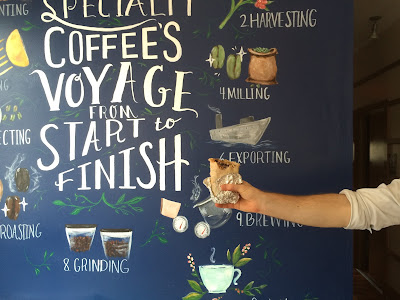Warning: If you read this,
you’re probably going to want to get your hands on one of South Philly
Barbacoa’s tortas. My apologies in advance -- you’ll have to settle for their
just-as-stellar tacos on the weekends. The owners stopped making their tortas
on the weekdays because they wanted more time for life, outside the restaurant… and
we really can’t blame them for that.
South Philly Barbacoa was listed as one of Bon Appétit’s
top 10 new restaurants this summer. The tiny taco and torta spot is busier
these days – it was especially bustling the week after Bon Appétit published their list, when I met a few friends there
for lunch.
I took the opportunity to
talk lunch with James, a teacher at Philadelphia Electrical and Technical
Charter School (and also a friend of a friend). During his last week of summer
vacation, he made his first trip to South Philly Barbacoa.
The feeling of the place is
somewhere between a home kitchen and a restaurant. Paper napkins are stuffed in dried gourds that sit next to flower
bouquets on each table. There’s an old-school coca cola drink cooler stocked
with lemonade, strawberry lemonade, and free bottles of water. We noticed a lone
copy of the Bon Appétit summer issue
(with their #6 listing) stashed behind the cooler, clearly an afterthought.
From his seat near the
window, James had a view of co-owner Cristina Martinez slicing bread for tortas
and stirring big pots of simmering beans and albóndigas (Mexican meatballs,
typically made with beef or pork).
 Martinez’s husband and
co-owner Ben Miller came over to our table to tell us the day’s menu. He ran
through a list of tortas (their former weekday-only sandwiches): potato
chorizo, chicken with mole poblano, albóndigas with salsa verde, and
double-cream queso fresco with
avocado and refried beans. James ordered the potato chorizo torta and a watermelon agua fresca.
Martinez’s husband and
co-owner Ben Miller came over to our table to tell us the day’s menu. He ran
through a list of tortas (their former weekday-only sandwiches): potato
chorizo, chicken with mole poblano, albóndigas with salsa verde, and
double-cream queso fresco with
avocado and refried beans. James ordered the potato chorizo torta and a watermelon agua fresca.
He says his typical lunch is
pretty basic during the school year. If he packs a lunch, it’s a sandwich with
lunchmeat, cheese, and mayo. No lettuce, no tomato. “I mean like the basic,” he says. Sometimes he pops next door to grab a sandwich
at CVS, or gets something from a nearby food truck. He never eats in the
cafeteria. “From what I’ve heard from the kids, it’s not the best,” he says. (I
bet you’re not surprised… isn’t it tragic that bad school lunch food is so normal?)
James is happy to have
fourth period lunch this year, which means he’ll eat at 11:15 (unless he has to
grade papers or talk with students during lunchtime, in which case he’ll wait
until dismissal at 2:12). “Some of my coworkers eat lunch at 10:30am,” he says.
Those teachers – and students – are stuck in the cafeteria basically just after
breakfast and left with a long stretch to last until school is over.
But at Barbacoa, James was
able to enjoy his torta right in the
middle of the day, without any academic distractions. Soft potatoes smothered
in the spicy juices of the chorizo, topped with tomato and avocado and smashed
into the fresh torta bread Cristina used to make each week. (I only know this
because I tried a bite. When I asked James what was in it, he said, “I have no
idea, I just ate it.” He was hungry
and it was just too good to slow down.)
Next week he’ll be back in
the classroom, teaching ninth-grade English. He says he’s strict with the kids
at first, which is hard to imagine if you’ve met the enthusiastic,
quick-to-smile guy outside of school. Like in a Mexican restaurant, for
example, where he sipped bright pink watermelon juice with and bobbed his head to the latin music. “I gotta
get this Pandora station,” he said as we stood up to leave. “I’ve been jammin’ out this
whole time!”
Just give him some time,
ninth graders; he’ll lighten up as the year goes on.

















